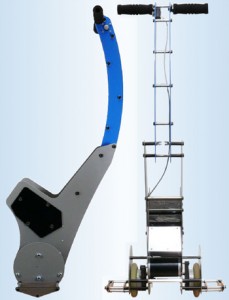 Dopo il software Open Source e l’hardware (vedi il successo strepitoso di Arduino) adesso arriva anche un veicolo auto bilanciante, sulla scia del Segway. Il progetto è stato realizzato dalla rivista Elektor ed è possibile anche acquistarne il kit di costruzione.
Dopo il software Open Source e l’hardware (vedi il successo strepitoso di Arduino) adesso arriva anche un veicolo auto bilanciante, sulla scia del Segway. Il progetto è stato realizzato dalla rivista Elektor ed è possibile anche acquistarne il kit di costruzione.
Ecco le caratteristiche:
OSPV1 specifications
- Weight: 25 kg (55 lbs)
- Height: 120 cm (47.2 inch)
- Width: 47 cm (18.5 inch)Depth: 47 cm (18.5 inch)
- Maximum load: 90 kg (200 lbs)
- Ground clearance (under steps): 20 mm (0.8 inch)
- Foot height (on steps): 5.6 cm (2.2 inch)
- Width between steps: 29.5 cm (11.6 inch)Range: 8 km (5 miles)
- Turning circle: 0 m
- Max. speed: 15 km/h (9.3 mph)
- Wheels: Polyurethane, 14 cm dia. (5.5 inch)
- Motors: DC, 2 x 200 W
- Drive train: HDT toothed belt
- Batteries: 2x lead-acid gel-cell CTM ct0-12L, 9 Ah 12 V
- Charger: Suitable for Europe (230 V) and North America (110 V)
- Charging time: 2.5 hours
It’s for indoors
Ultimately it’s up to you (subject to local regulations) to decide where you want to travel with the OSPV1, but it is intended to be used indoors. It’s not especially well suited to negotiating bumps or uneven surfaces, since it has a ground clearance of just two centimetres. The two wheels, which have a diameter of 14 centimetres, are far enough apart to keep you well balanced, but they do not provide much clearance for driving over thresholds or other types of bump. However, it drives like a charm on any sort of flat floor – including factory floors, school corridors, and the corridors of our office building. The rider stands with both feet outside the wheels. Stepping onto the OSPV1 takes a bit of practice, but thanks to the low centre of gravity it feels very stable.
It’s easy to steer
Once you have your feet positioned properly, all you have to do to get the OSPV1 rolling is to lean forwards or backwards. With the Elektor Wheelie you move the steering column to the left or the right to negotiate curves, but with the OSPV1 you use a small joystick for this. The vehicle responds immediately to joystick movements, so it’s easy to perform pirouettes and other elegant manoeuvres. In fact, it would be right at home in a ballroom. The attitude of the OSPV1 is saved when it is switched on and is subsequently used as a reference, so you should ensure that the steps are level (horizontal) during this process.
It’s light and foldable
The OSPV1 is designed to be taken apart easily, so it can be stowed conveniently in the boot of a car. It’s also relatively light. It weighs j ust 25kg, so you don’t have to be a muscleman to pick it up. The pivot and fixing point is on the steering column, which comes apart after you loosen two wing nuts. I’m willing to bet that many of you will be inspired to apply your creativity to this and perhaps come up with a smarter and easier solution. You’re welcome to do so – the OSPV1 is very amenable to simple modifications.
It’s open source
The nice thing about the OSPV1 is that you can configure or modify it to suit your wishes. The electronics are the same as in the Elektor Wheelie, the software is freely available, and you can even modify the software to alter the handling characteristics. Everyone who has been involved in developing extensions for the Elektor Wheelie can also use them with the OSPV1. The schematic diagrams, PCB design and source code listing are all available on the Elektor website. The OSPV1 is supplied with a charger for the two 12-V rechargeable batteries, which have a capacity of 9 Ah.
What you can do with it
The OSPV1 is primarily intended for moving people, but it doesn’t have to be limited to that. A variety of other uses are conceivable, ranging from an electric wheelbarrow to a handy motorised shopping cart. This is where the advantages of the open source approach come to the fore. Everyone is free to work on the design and turn it into something special. As already mentioned, it is intended for indoor use, which also includes factory buildings, terminals, school corridors, and so on – as long as the floor is flat, the OSPV1 can run on it. As for street use, we should point out that using vehicles such as this on the street is subject to rules and regulations, which may vary from country to country. There’s also an upper limit on the rider’s weight; anything up to 85 kg is perfectly OK. Finally, you should give some thought to body protection – after all, you’re riding on a moving vehicle.
It looks smart
Of course tastes vary, but up to now the OSPV1 has drawn only positive responses. During our test runs we heard comments like “hey, that’s neat”, “nice device”, or simply oohs and aahs. The structure is open and intentionally light, with clean lines.